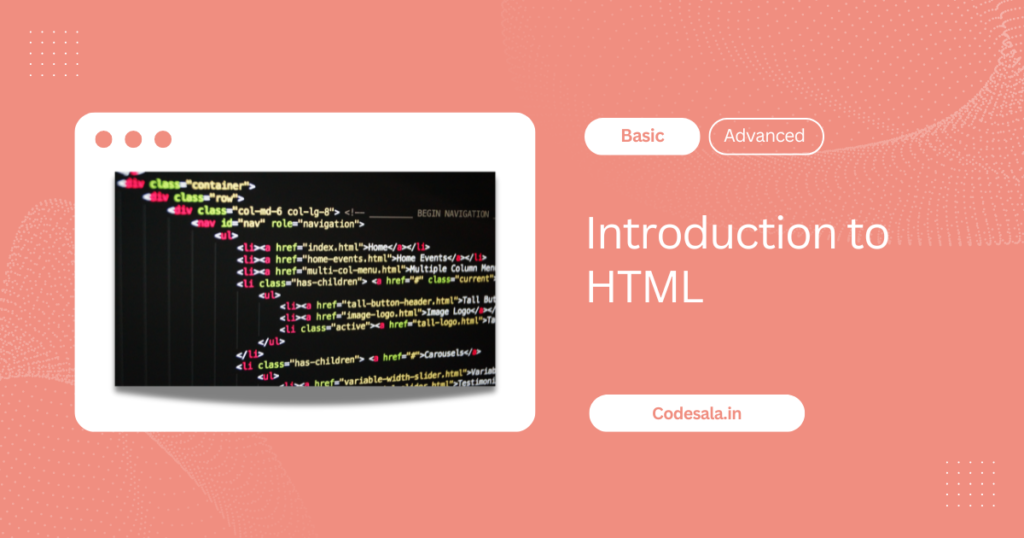
Introduction to HTML

1. What is HTML?
HTML (HyperText Markup Language) is the standard language used to create and design web pages. It provides the basic structure of a webpage, which is then enhanced and modified by other technologies like CSS (Cascading Style Sheets) for presentation and JavaScript for interactivity. HTML is a markup language that uses a set of tags to define elements within a document, allowing browsers to interpret and display the content appropriately.
2. History of HTML
HTML was created by Tim Berners-Lee in 1991, and it has gone through multiple versions since its inception. The most significant versions include:
- HTML 2.0 (1995): The first standard version.
- HTML 4.01 (1999): Introduced many new tags and attributes, laying the foundation for modern web development.
- XHTML (2000): A stricter version of HTML 4.01, combining HTML and XML.
- HTML5 (2014): The latest major version, which introduced many new features for multimedia, graphics, and improved semantic elements.
3. Basic Structure of an HTML Document
An HTML document consists of various elements enclosed within tags. These elements define the structure and content of the web page. The basic structure of an HTML document looks like this:
<!DOCTYPE html>
<html lang="en">
<head>
<meta charset="UTF-8">
<meta name="viewport" content="width=device-width, initial-scale=1.0">
<title>Page Title</title>
</head>
<body>
<h1>Hello, World!</h1>
<p>This is a paragraph.</p>
</body>
</html>
<!DOCTYPE html>: This declaration defines the document type and version of HTML. It ensures that the browser renders the page in standard mode.<html>: The root element that contains all other HTML elements. It indicates the beginning and end of an HTML document.<head>: Contains meta-information about the document, such as the character set, page title, and links to CSS files.<meta charset="UTF-8">: Specifies the character encoding for the document, ensuring that text is displayed correctly.<meta name="viewport" content="width=device-width, initial-scale=1.0">: Ensures the page is responsive, scaling correctly on different devices.<title>: Defines the title of the document, which appears in the browser’s title bar or tab.<body>: Contains the content of the document, such as text, images, links, and other media.
4. DOCTYPE Declaration
The <!DOCTYPE> declaration is an essential part of an HTML document, located at the very top of the file. It tells the web browser what version of HTML the page is written in, which helps ensure that the content is rendered correctly. In modern web development, the <!DOCTYPE html> declaration is used for HTML5, which is the latest version of HTML.
5. HTML Tags and Elements
HTML uses tags to structure the content on the web. A tag is enclosed within angle brackets, like <tagname>. Tags typically come in pairs: an opening tag (e.g., <p>) and a closing tag (e.g., </p>). The content between these tags is known as an element.
For example:
<p>This is a paragraph.</p>
In this example:
<p>is the opening tag.</p>is the closing tag.This is a paragraph.is the content inside the<p>element.
6. Nesting Elements
HTML allows for elements to be nested within other elements. This helps in creating complex structures and layouts. When nesting elements, it’s important to properly close them in the reverse order in which they were opened.
Example:
<div>
<h2>This is a heading</h2>
<p>This is a paragraph inside a div.</p>
</div>
7. Self-Closing Tags
Some HTML tags are self-closing, meaning they do not need a separate closing tag. These tags typically represent empty elements, such as line breaks or images. In HTML5, it is common to see self-closing tags written without a slash.
Examples:
<br> <!-- Line break -->
<img src="image.jpg" alt="Description of the image"> <!-- Image -->
8. Case Sensitivity in HTML
HTML tags are not case-sensitive, meaning <p> is equivalent to <P>. However, it is considered good practice to write tags in lowercase for consistency and readability.
9. HTML Comments
Comments in HTML are not displayed in the browser but are useful for adding notes or explanations within the code. Comments are written using the following syntax:
<!-- This is a comment -->
10. Conclusion
HTML is the foundational language for building web pages. Understanding its basic structure, elements, and best practices is crucial for anyone looking to create websites or work in web development. As you progress from basic to advanced topics, you’ll learn how to use HTML in combination with CSS and JavaScript to create dynamic, interactive, and responsive web pages.

kumar
The Managing Director oversees the overall operations and strategic direction of the organization.
Category
- .NET (3)
- Blog (2)
- Common Technology (1)
- CSS (1)
- Topics (1)
- HTML (4)
- Basic HTML (4)
- Javascript (1)
- Topics (1)
- Laravel (32)
- Php (153)
- PHP Arrays (9)
- Php Basic (1)
- PHP interview (152)
- PHP Strings (12)
- Python (15)
- Python interview (13)
- React.js (32)
- React Js Project (3)
- Uncategorized (118)
- WordPress (114)
- Custom Post Types (7)
- Plugin Development (12)
- Theme Customizer (3)
- Theme Development (1)
- Troubleshooting (9)
- WordPress Customization (13)
- Wordpress Database (10)
- WordPress Example (5)
- WordPress Multisite (9)
- Wordpress Project (3)
- WordPress REST API (14)
- WordPress SEO (10)
Recent Posts
Tags






